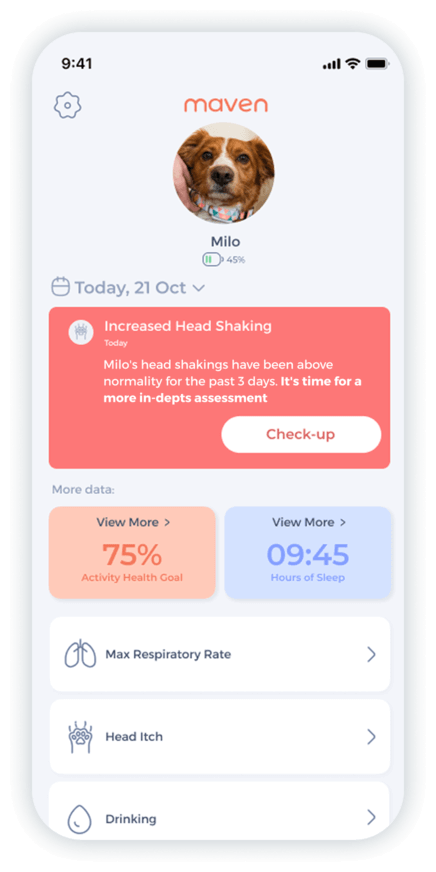Understanding Dog Seizures and How to Help
Witnessing your dog experiencing a seizure can be a truly frightening experience. Their bodies contort, they lose consciousness, and the whole ordeal can leave you feeling helpless. However, with knowledge comes power – and understanding dog seizures is the first step towards supporting your furry friend.
This blog post will equip you with the information you need to recognize seizure symptoms, explore potential causes, and learn how to monitor and potentially prevent your dog from having seizures.
“I got the Maven sensor for my 14-year-old Chihuahua mix with heart and trachea issues. It gave me back peace of mind – I can track her RRR, BPM, drinking, and activity anytime and know instantly if something’s wrong. Highly recommend!”

★★★★★
Chiara De Luca
Titti
- Recognize seizure symptoms: uncontrolled movements, drooling, loss of balance, and post-seizure confusion.
- Epilepsy can be idiopathic or secondary due to health issues like tumors or injuries.
- Genetics, toxins, health conditions, and head trauma can trigger seizures in dogs.
- Monitor your dog with a seizure diary and watch for behavioral changes.
- Regular vet checkups and lifestyle adjustments can help prevent seizures.
Recognizing Dog Seizure Symptoms
Seizures occur when there’s a sudden surge of electrical activity in the brain. This disrupts normal functioning and can manifest in various ways.
Some of the most common signs of dog seizures are:
- Uncontrolled muscle movements: This could be paddling of the limbs, stiffening of the body, or twitching of facial muscles.
- Drooling or foaming at the mouth: This is a common response to abnormal electrical activity.
- Loss of balance or consciousness: Your dog may stumble or fall, and their eyes may become glazed over or unresponsive.
- Temporary confusion or disorientation after the seizure ends: Once the seizure subsides, your dog may seem dazed or disoriented for a short while.
Remember: If you witness these symptoms, stay calm and observe your dog. Time the seizure with a stopwatch and make note of any specific behaviors. This information will be crucial when discussing the event with your veterinarian.
However, it is important to understand that not every episode of unusual behavior constitutes a seizure. For a definitive diagnosis, consulting a veterinarian is essential.
Understanding Epilepsy in Dogs

Epilepsy is a neurological disorder characterized by recurrent seizures. In many cases, dog seizures are the primary symptom of canine epilepsy. There are two main types of canine epilepsy:
- Idiopathic epilepsy: This form has no identifiable underlying cause and is often diagnosed by ruling out other potential causes of seizures.
- Secondary epilepsy: This type arises due to another medical condition, such as a brain tumor, head injury, or infection.
If your dog is diagnosed with epilepsy, it’s important to remember they can still live a happy and fulfilling life.
Typically, epilepsy in dogs requires long-term management with medication and lifestyle adjustments. Your veterinarian will develop a treatment plan specific to your dog’s needs.
Causes of Seizures in Dogs
While epilepsy is a frequent culprit, seizures can also be triggered by other factors, such as:
- Genetic factors or hereditary conditions: Certain breeds, like Beagles and Poodles, are predisposed to developing epilepsy.
- Exposure to toxins or poisons: Ingesting harmful substances like pesticides or household cleaners can cause seizures.
- Underlying health conditions: Diseases like liver or kidney disease can disrupt brain function and lead to seizures.
- Head injuries or trauma: Traumatic injuries to the head can cause seizures, especially if there’s internal bleeding or swelling.
How to Monitor and Prevent Seizures in Dogs
There are several steps you can take to actively monitor and potentially prevent your dog from having seizures:
- Keep a seizure diary: Track the frequency, duration, and severity of your dog’s seizures. Note any potential triggers that could be contributing, such as changes in weather, exposure to specific substances, or stressful situations.
- Observe and record any changes in behavior or health: Even subtle changes, like a decrease in appetite or increased lethargy, could be early indicators of an impending seizure.
- Use the Maven Pet Health Monitor: This innovative tool can be your eyes and ears when you’re not around. The Maven Pet smart collar provides continuous health tracking and can detect early indicators of unusual activity or restlessness that might be precursors to a dog seizure. Early detection allows you to intervene swiftly and potentially prevent a full-blown seizure.


Monitor heart rate, respiratory rate, activity & rest, drinking, itch behavior.
Prevention
While some causes of seizures are unavoidable, there are proactive steps to potentially minimize their occurrence:
- Regular vet checkups: Maintaining a regular schedule of vet visits ensures your dog receives timely vaccinations, parasite prevention, and overall health assessments.
- Lifestyle adjustments: Maintaining a healthy weight and regular exercise routine can contribute to your dog’s well-being and potentially reduce susceptibility to seizures.
- Minimize exposure to known seizure triggers: If you can identify specific triggers for your dog’s seizures, such as flashing lights or loud noises, make adjustments to mitigate their impact.
Final Notes
While witnessing dog seizures can be alarming, understanding the underlying causes and taking proactive steps can significantly alleviate anxiety and improve your pet’s quality of life.
By recognizing the signs, seeking veterinary advice, and implementing appropriate monitoring strategies, you can empower yourself to provide the best possible care for your furry friend.
Maven Pet Health Monitor is a valuable tool in your pet’s health journey.
By continuously tracking your dog’s activity and detecting early signs of unusual behavior, you can address potential issues early and work closely with your veterinarian to ensure your pet’s well-being.
You can learn more about how the Maven Pet Health Monitor works for pet wellness here.
Maven Pet focuses on improving the quality of life of our pets with technology, using artificial intelligence (AI) to enable proactive pet care. By accurately collecting and monitoring pet data 24/7 and flagging any irregularities, Maven Pet empowers pet parents and veterinarians to stay ahead of potential health issues, ensuring the well-being and longevity of our beloved companions.




